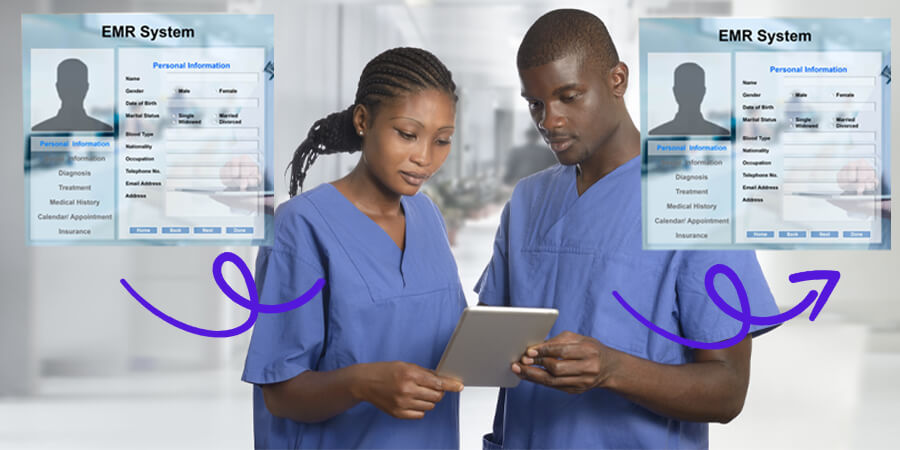Health technology in Africa has been rapidly evolving in recent years, driven by the need to improve the quality of healthcare delivery, expand access to healthcare services and address the continent’s unique challenges. One of those new health technologies is “Electronic Medical Records” (EMRs), which are digital versions of a patient's medical history that contain information about diagnoses, medications, test results, and treatment plans. The use of EMRs has become increasingly popular in healthcare as they facilitate better communication and coordination between healthcare providers, improve patient safety and increase efficiency in healthcare delivery. So, what exactly are the potentials of EMRs for improving healthcare in Africa?
Benefits
One of the main benefits of EMRs is that they can improve patient safety by reducing errors in diagnosis and treatment. EMRs can alert healthcare providers to potential drug interactions or allergies and provide them with up-to-date information about a patient's medical history. Such details can help ensure that patients receive the correct treatment and reduce the risk of adverse events.
EMRs can also facilitate better coordination of care between healthcare providers. For example, if a patient sees multiple doctors or receives care in different healthcare facilities, EMRs can ensure that all healthcare providers have access to the same information about the patient's medical history and treatment. This can help to prevent duplicate tests, reduce the risk of medication errors and improve the overall quality of care.
In addition, EMRs can increase efficiency in healthcare delivery by reducing the amount of time healthcare providers spend on administrative tasks, such as filling out paper forms or searching through patient records. This can allow healthcare providers to spend more time on patient care, which can improve patient outcomes and satisfaction.
Challenges
Despite the many benefits of EMRs, there are also challenges associated with their implementation. One of the main challenges is the high cost of implementing EMRs, which can be a barrier to adoption in resource-limited settings. In addition, there may be technical issues associated with the use of EMRs, such as problems with connectivity, data entry and data quality.
Another challenge is the resistance to change among healthcare providers. Many healthcare providers may be used to working with paper records and may be reluctant to adopt new technologies. This can make it difficult to achieve widespread adoption of EMRs and may slow down the pace of innovation in healthcare.
In addition, the implementation of an Electronic Medical Records (EMR) system is a major investment for healthcare institutions, with costs that include hardware, software, implementation assistance, training, support and ongoing network fees. As a result, the high cost of EMR implementation is a significant barrier to many healthcare providers adopting this technology. However, despite the challenges posed by the cost of EMR, the benefits of this technology are numerous and can greatly outweigh the initial investment.
EMRs in Africa
EMRs have the potential to make a significant impact on healthcare in Africa, where there are often limited resources and infrastructure for healthcare delivery. There are several examples of successful implementation of Electronic Medical Records (EMR) systems in Africa. One such example is the iSante EMR system, which has been implemented in several African countries, including Rwanda, Haiti and Kenya. The iSante EMR system is an open-source EMR system that allows for the management of patient health records, clinical decision-making and patient care.
The implementation of iSante in Rwanda has helped improve the quality of healthcare services provided, while also increasing efficiency in the delivery of care. Specifically, the iSante EMR system has allowed healthcare providers in Rwanda to reduce the time spent on administrative tasks, resulting in more time for patient care. Additionally, the system has allowed for improved clinical decision-making through the collection and analysis of patient data.
Another successful example of EMR implementation in Africa is the OpenMRS platform. This open-source platform has been implemented in several African countries, including Kenya, Uganda and Rwanda. OpenMRS is a flexible and customizable system that allows healthcare providers to adapt the system to meet their specific needs. It has helped to improve patient care in several African countries by providing a comprehensive record-keeping system that allows healthcare providers to access patient information quickly and efficiently. The system has also helped to improve the accuracy of data collection, leading to more accurate diagnoses and better patient outcomes.
In conclusion, while the cost of implementing an EMR system may initially appear to be a significant challenge, it is important for healthcare institutions to weigh the benefits against the costs. By assessing your specific needs, consulting with vendors, and considering the long-term financial benefits, healthcare providers can develop an economical EMR solution that can greatly enhance patient care, improve efficiency and ultimately benefit the institution's bottom line.
